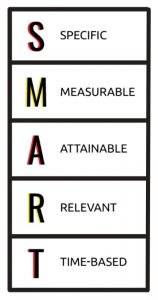If you’re reading this article, you’re probably looking for an effective way to set up your business for success. S.M.A.R.T goals are a great start. While lofty goals may lead to higher achievements than otherwise possible, they can also lead to failure if it is not approached correctly which in turn might have adverse effects on our attitudes to continue to strive forward. Therefore, it’s important that these lofty goals are not vague. Simply put – vague won’t get done as there is no path to follow to achieve. Setting Specific, Measurable, Attainable, Realistic, and Timely goals will help provide that path which will lead you to success.
Where do we start? We start with knowledge. In this blog post we’ll go over the importance of setting smart goals, what SMART goals means and how to apply them. Finally, there is a worksheet at the end that you can utilize to create your very own SMART goals. Overall, SMART goals are a great tool to get started in your journey of growth!
Understanding the goals of your business is foundational to this process, but it is not the finish line. You may be tempted to say your goal is to “Increase Brand Awareness” but what does that actually mean for your business? Developing SMART goals for your business is what can take you from vision to execution by increasing accountability. SMART goals provide direction, clarity and most importantly, it drives action.
In this blog we will discuss the following:
What does the S.M.A.R.T acronym stand for?

Let’s dive in.
Specific
Specificity helps us figure out the path between where we are and where we want to be. Let’s start with our example from above, something very common here at Peralta Design. We ask potential clients of their marketing goals and here’s what they say:
“I want to increase Brand Awareness”
Problem with this is there are endless ways of achieving this and everyone has a different definition of what this may mean.
What does brand awareness mean to you? What point do you want to increase it from? And how much do you want to increase it by? Do you want more organic traffic? Do you want to increase your social media presence? What time frame are you looking to accomplish this? Which avenues would be best for this? Who will be responsible for this goal? What are the milestones?
When a goal isn’t specific there’s no way to tell if the marketing strategy actually worked as there’s no way to attribute it to success. If you specify your goal to: increase the number of visitors to your website in the month of December by 30% for example, then you can narrow the marketing tactics to achieve this. In this situation, we can spend a couple months developing an SEO strategy by creating relevant blog posts, and as we get closer to the goal date, Google Ads could be appropriate, as well as some retargeting social media advertising. Therefore having a specific goal helps make your marketing strategy and next steps more clear.
To others, brand awareness may mean increasing their followership on social media. So the specified goal would be to: increase the number of followers you have on Instagram to 10k by the end of the fiscal year.
As you may know, this goal would need an entirely different strategy from increasing website visitors. For social media growth you need to focus more on developing content, advertising on social platforms, ensuring you’re talking to the various audiences you reach on these platforms. While Google Ads would be a great tactic to increase your website visitors it would not really be as effective to gain social media followers. Similarly, creating blogs would not increase your instagram followers, however it could assist in content creation by taking snack sized bites out of the blog that can be utilized on social media. This shows the importance of creating a specific goal as it will help you narrow down your strategy so that you can achieve it in the most effective manner possible.
Measurable
Measurability helps you evaluate the success or failure of your efforts. Whether you make deadlines, percent changes, or a number to reach, to create a smart goal you must have an objective way of measuring them. One way to do this could be to utilize benchmarking, in other words, starting points. The idea for benchmarking is understanding what is typical for your company. For example, utilizing Google Analytics (GA4) year model (discussed in our other blog: Data Driven Decisions) can help you see what trends your website sees throughout the year or will show you how much from the norm you’ve increased traffic within the past year etc. Asking yourself questions like how much or how many, how do I know if I reached my goal or what is my indicator of progress will help you ensure you have created a goal that is measurable.
GA4 is Google’s newest version of the popular and free website analytics tool. This updated version is quite a bit different from the previous Universal Analytics (UA). The most important note is that before you switch over to GA4, no data will be collected on this platform. Therefore, you will not be able to utilize GA4 for benchmarking or tracking progress until it’s turned on. If you wait until the last date to convert (June 30, 2023), you will be essentially starting from scratch, so start collecting your data now. If you aren’t sure how to convert to GA4 don’t worry, we are here to help. We will set up your GA4 from activating to transport, all for one flat fee of $500 – Learn more today.
Going back to our example of the common business goal of increasing brand awareness, it’s hard to attribute success as there is nothing to compare an increase to. If there is no goal or benchmark how will we know if the marketing strategy was successful. Additionally, without putting an actual numerical value to the goal it’s hard to determine what success looks like as one goal (increasing a 30% website traffic increase every month) may take a lot more time and dedication than another (increasing 30% website traffic for one month). A numerical goal is valuable as it can provide you something to strive for and provide you with a better roadmap of how to succeed.
Attainable
It’s easy to have big aspirations and shoot for the moon, and we encourage it, however, it’s important to make these actually realistic and balanced between long term and short term goals. Short term goals are goals you can achieve relatively soon – within the next few months to a year. While long term goals are usually completed within the next 3-5 years. In essence achieving your short term goals should put you on a path to help you achieve your long term goals.
Setting attainable goals begins with looking at what you’ve been able to achieve already and adjusting your goals to be realistic in relation to that progress. Attainable goals help you maintain momentum as it gives you a little serotonin boost when you achieve the goals versus feeling discouraged to miss huge targets.
Do not mistake attainable goals for not making stretch goals for yourself! Stretch goals are challenging on purpose but are still possible to meet and therefore are still attainable.
Let’s bring this back to our example of increasing brand awareness. Your goal should be attainable therefore, if you look at your website traffic over the past month or year the goal you are setting for yourself should be in the realm of possibilities for your company to achieve. For example, if you see your company got 5k visitors on your site in the last year it’s not realistic to set out to gain 20k visitors in a year unless you put significant money behind your efforts. Instead, create a goal that’s based on your benchmark, if you’ve seen yourself have 5k visitors over the last year, then aim to increase your visitors by 2k this next year (to 7k visitors). While this may not be 20k visitors to your website, it’s still a 40% increase over last year’s traffic.
Relevant
Relevant goals help you move your business into the right direction. While there are a thousand different things you can do with your time to build and promote your business, your time is limited. Therefore, ensuring that your goals truly speak to the direction you want your business to take is critical for success and improvement. Don’t set goals just as an exercise for something to do instead ensure they actually help your business. A good way to make sure you are achieving this is by finding alignment between the long term and short term goals.
Going back to the example of increasing your Brand Awareness, a short term goal that’s relevant to this may be to develop blog posts in the months of September, October, and November displaying products offered that can generate strong traffic for the month of December. For example, maybe the content strategy is to develop a great gift series: Awesome gifts for Dad, The perfect gift for mom, gifts your partner will love. This way when December comes around you can create some retargeting campaigns for each blog post. Since they are relevant to an audience, you have a better understanding of what the messaging should be. This short term goal will help you achieve your long term goal of increasing website traffic by X amount. A relevant goal will allow you to make progress to achieve business goals.
Time-Based
Smart goals should have an end date. Without this, your project could drag on and on. Instead, deadlines promote a sense of urgency and allow you to build a clear timeline to ensure you can execute on your goals. These timelines also help you keep track of your progress and keep you on track.
In our previous example, you see that by setting the goal for a specific month, we can plan in advance what our tactics are, which months some would be active versus not. What do we need to do in order to be able to execute on those plans? Allocate time for research, development and execution.
That’s It!
Goals are great, and smart goals will help you stay on track and ensure your goals lead you to success. However, making the goal is just the first step. Now you still need to stay on track and achieve. So write them down, share them with relevant team members, regularly evaluate your progress, and celebrate wins (no matter how small!).
Download your free SMART goal worksheet!
Simply fill in your information to receive your very own smart goal worksheet. This worksheet will guide you with questions that help you make your goals be Specific, Measurable, Attainable, Relevant, and Time-bound.

